We are aiming to build up a collection of pictures of plants, particularly wild flowers photographed growing in Ryedale. The photos are roughly in order of flowering through the year. Plants flowering January–April and July–December are in different files, as are more from May–June. (This page could take a while for all the pictures to load...)
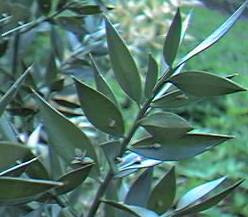 | Butcher’s Broom, Ruscus aculeatus
A curious member of the Lily family, this little shrub is approximately 2' tall. The spiny-tipped “leaves” are actually flattened stems, as can be seen from the tiny six-petalled flowers (male and female on separate plants) which grow in the middle of these “leaves” (lower left). It is probably not native this far north, but can be found growing apparently wild, for instance near Gilling Castle where this specimen was photographed. 8/5/99 |
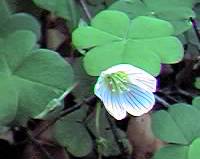 | Wood Sorrel, Oxalis acetosella
Still common in old-established woodland, this delicate flower is a welcome sign of spring. The fine purple veining is very beautiful close up; sometimes the whole flower is pinky-purple with darker veins (see detail, right).  The green “shamrock” leaves have a sharp acid tang, reflected in the Latin specific acetosella. 8/5/99 The green “shamrock” leaves have a sharp acid tang, reflected in the Latin specific acetosella. 8/5/99 |
 | Bird Cherry, Prunus padus
Often mistaken for a wild lilac, the bird cherry is locally common in Ryedale woods. It forms a shrub or small tree and is a true Prunus cherry, actually quite closely related to the wild cherry. The individual flower-spikes (see right) are very attractive; the flowers have a strong almondy scent during their brief flowering season, usually only a week or so in early May. The fruit is in the form of small black “cherries” far too bitter for human consumption! 29/4/2000 It forms a shrub or small tree and is a true Prunus cherry, actually quite closely related to the wild cherry. The individual flower-spikes (see right) are very attractive; the flowers have a strong almondy scent during their brief flowering season, usually only a week or so in early May. The fruit is in the form of small black “cherries” far too bitter for human consumption! 29/4/2000 |
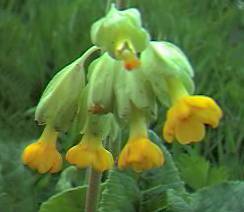 | Cowslip, Primula veris
Cowslips love sunny, grassy banks on limestone, and are still common in Ryedale. Like primroses the male and female flowers (or, rather, those showing the male or female parts clearly at the centre) grow on different plants (the thrum- and pin-eyed flowers respectively); unfortunately this photo does not show the “eye” clearly enough! 8/5/99 |
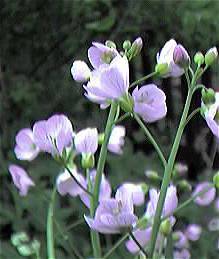 | Milkmaid, Lady’s Smock or Cuckoo Flower, Cardamine pratensis
Traditionally flowering as the cuckoos arrive the Milkmaid thrives in damp meadowland, particularly cattle pasture; unfortunately as this habitat is “improved” out of existence this beautiful flower is decreasing throughout the country. This little group was growing at the edge of the golf course at Gilling. The detail (right) shows a plant growing at the edge of the top fishpond in Gilling Woods on 29 April 2000. Milkmaids are usually mauve, but sometimes they are almost white, when they can be confused with the related Large Bittercress, which has purple anthers whereas those of the Milkmaid are yellow. 9/5/99 unfortunately as this habitat is “improved” out of existence this beautiful flower is decreasing throughout the country. This little group was growing at the edge of the golf course at Gilling. The detail (right) shows a plant growing at the edge of the top fishpond in Gilling Woods on 29 April 2000. Milkmaids are usually mauve, but sometimes they are almost white, when they can be confused with the related Large Bittercress, which has purple anthers whereas those of the Milkmaid are yellow. 9/5/99 |
 | Early Purple Orchid, Orchis mascula
Early Purple Orchids are still fairly common on unimproved limestone grassland and in old woodland, again mainly on lime. The spikes can grow up to a foot tall, and often show quite a variation on colour from pale pink to dark purple (this is especially true in Sinnington Woods which usually have a marvellous show of these orchids along with primroses, false oxlips, violets and lily-of-the valley). The commonest orchid in Ryedale, but still a pleasure to find. The superficially similar Green-winged orchid is much rarer, known in this area only from the Hole of Horcum.
 
Two colour variations seen, May 2000.
10/5/99 |
 | Bluebell, Hyacinthoides nonscripta
Bluebells still grow in many Ryedale woods, often carpeting the ground. Close up the flower’s close relationship to hyacinths is clear. Occasionally the flowers are pure white; this seems to happen more in some woods than others but I do not know the reason.
 
Unfortunately the photos cannot produce the wonderful scent! 10/5/99; 21/5/03 white specimen |
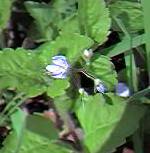 | Wood Speedwell, Veronica montana
 A rather pale, yellowish-green, weedy speedwell, with pale mauve-blue flowers, it grows in many Ryedale woods, often in quite large patches. It cn be mistaken for the much bluer, more upright birdseye speedwell, but that does not often grow in woods. 12/5/03 A rather pale, yellowish-green, weedy speedwell, with pale mauve-blue flowers, it grows in many Ryedale woods, often in quite large patches. It cn be mistaken for the much bluer, more upright birdseye speedwell, but that does not often grow in woods. 12/5/03 |
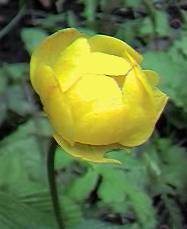 | Globe Flower, Trollius europaeus
Related to the buttercups, Globe Flowers grow in wet, marshy grassland. They are not particularly common in Ryedale. They are a paler yellow than most buttercups, and the many-petalled flower is almost completely spherical. 19/5/99 |
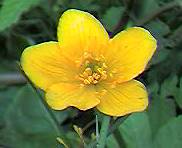 | Kingcup or Marsh Marigold, Caltha palustris
Like a large buttercup (to which they are closely related) with glossy leaves, Marsh Marigolds grow in damp meadows and on the margins of ponds and streams, often in woodland. They are common in Ryedale and make a welcome splash of bright colour. 19/5/99 |
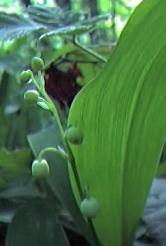 | Lily of the valley, Convallaria majalis
The ancestor of the garden flower, wild lilies still grow in undisturbed woodland on limestone in Ryedale. The flowers are much smaller than the cultivated forms, and often only one or two plants in a patch produce flowers at all. Apparently lilies of the valley used to be much commoner than now, but many were dug up and sold in Victorian times, especially round Helmsley! 19/5/99 |
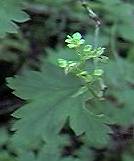 | Mountain Currant, Ribes alpinum
A rather untidy shrub some 5' tall, this relative of red- and blackcurrants grows in old-established woodland on limestone, for example round Rievaulx. The insignificant greenish flowers produce red berries, rather tasteless to humans but eaten by birds. It is not common. 19/5/99 |
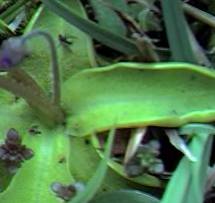 | Butterwort, Pinguicola vulgaris
A curious plant of bogs, the Butterwort is insectivorous. The sticky leaves which resemble a green starfish catch insects (a fly can be seen towards the top) and then produce digestive juices which dissolve nutrients from them. (This is necessary because the plants grow in areas deficient in nitrogen.) Butterworts have attractive flowers rather like a violet. 19/5/99 |
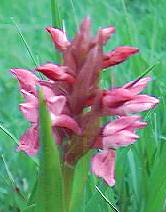 | Early Marsh Orchid, Dactylorhiza incarnata
The Dactylorhiza marsh orchids are a difficult group to identify accurately as they hybridise freely. They grow in damp meadowland which has not been “improved”, sometimes in considerable numbers. This Early Marsh orchid is a characteristic flesh-pink colour, with the sides of the lower lip turned back. 19/5/99 |
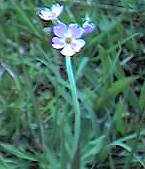 | Birdseye Primrose, Primula farinosa
This charming relative of the primrose is common in parts of the Pennines but not in Ryedale. It grows in a few places on limestone grassland around Rievaulx. Only a few inches tall, the flowers are intermediate in size between common primrose and cowslip. They are a warm pinky-purple, a colour which is very hard to capture in a photo! 19/5/99 |
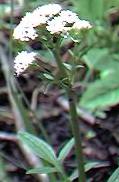 | Marsh Valerian, Valeriana dioica
The smaller of the two wild valerians, Marsh Valerian is a neat plant about 9" tall, growing in marshy meadows and boggy areas, sometimes in woods. The flowers are white or very pale pink. 19/5/99 |
 | Herb Paris, Paris quadrifolia
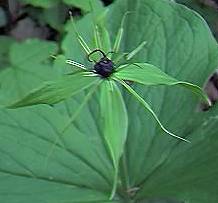 A curious plant, not closely related to any other British wild flower (allied to Trillium). Herb Paris is uncommon, growing in damp spots in old, undisturbed woodland on limestone. It is hard to spot growing among Dog’s Mercury, reaching almost a foot in height; usually a colony of a dozen or so plants are found growing together. The whole plant is divided into fours, from the leaves (see left) to the various elements of the flower – 4 sepals, 4 petals, 8 stamens, 4 styles (see detail, right). The fruit is a black berry. 19/5/99 A curious plant, not closely related to any other British wild flower (allied to Trillium). Herb Paris is uncommon, growing in damp spots in old, undisturbed woodland on limestone. It is hard to spot growing among Dog’s Mercury, reaching almost a foot in height; usually a colony of a dozen or so plants are found growing together. The whole plant is divided into fours, from the leaves (see left) to the various elements of the flower – 4 sepals, 4 petals, 8 stamens, 4 styles (see detail, right). The fruit is a black berry. 19/5/99 |
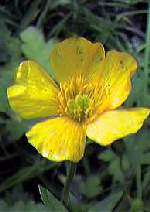 | Creeping Buttercup, Ranunculus repens
 Probably the commonest buttercup, with shiny bright yellow flowers; grows along roadsides, in hedge bottoms and as a garden weed, with runners that root rather like strawberries. The sepals lie up close against the petals (detail right), in contrast to those of Bulbous Buttercup (below), and the flower-stalk is noticeably ridged. This buttercup usually comes into flower at about the same time as the taller Meadow buttercup (below) and then continues right through the summer.The leaves often have pale blotches on them 30/5/99; 21/5/3 (detail) Probably the commonest buttercup, with shiny bright yellow flowers; grows along roadsides, in hedge bottoms and as a garden weed, with runners that root rather like strawberries. The sepals lie up close against the petals (detail right), in contrast to those of Bulbous Buttercup (below), and the flower-stalk is noticeably ridged. This buttercup usually comes into flower at about the same time as the taller Meadow buttercup (below) and then continues right through the summer.The leaves often have pale blotches on them 30/5/99; 21/5/3 (detail) |
 | Bulbous Buttercup, Ranunculus bulbosus

Similar to creeping buttercup (above) but usually a little taller and more delicate; the diagnostic feature of this species is the sepals, which turn back from the petals, and also the base of the stem which is thickened into the bulb-like feature that gives the plant its name. This flower tends to bloom a week or so earlier than the creeping buttercup (or the taller meadow buttercup) but later than Goldilocks. 12/5/03 |
 | Meadow Buttercup, Ranunculus acris
This is the latest-flowering of the three common buttercups. It is usually taller and altogether more delicate than the other two (Creeping and Bulbous Buttercups, above) with finely divided leaves that can look remarkably like thoe of meadow cranesbill. It is a variable species, and usually grows in damp meadows. It is the classic buttercup of old-fashioned “buttercup fields” and water-meadows, often growing 18" or so tall. Note that the flower-stalks are round and smooth, not grooved.21/5/3 |
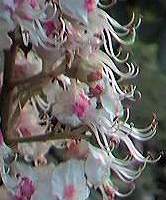 | Horse Chestnut, Aesculus hippocastanum
 This stately tree is an introduction but grows well especially in parkland. The large, ornamental flower “candles” are a splendid sight in late spring. Later, of course, they produce conkers in their outer spiny protective “hedgehog” fruits. The flowers are beautiful seen close up (left) as well as in groups (right). 30/5/99 This stately tree is an introduction but grows well especially in parkland. The large, ornamental flower “candles” are a splendid sight in late spring. Later, of course, they produce conkers in their outer spiny protective “hedgehog” fruits. The flowers are beautiful seen close up (left) as well as in groups (right). 30/5/99 |
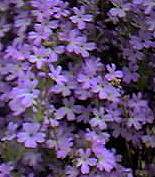 | Fairy Foxglove, Erinus alpinus
 Not really a foxglove (though in the same botanical family Scrophulariaceae), this pretty little plant grows up to 6" tall. It is an introduction, probably a garden escape, but finds conditions on the walls of Helmsley Castle greatly to its liking (see right). The flowers are very attractive close up (left). 29/5/99 Not really a foxglove (though in the same botanical family Scrophulariaceae), this pretty little plant grows up to 6" tall. It is an introduction, probably a garden escape, but finds conditions on the walls of Helmsley Castle greatly to its liking (see right). The flowers are very attractive close up (left). 29/5/99 |
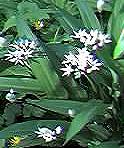 | Ramsons or Wild Garlic, Allium ursinum
 Wild Garlic covers vast areas in Ryedale’s woods, often carpeting the ground completely (below). The leaves are broad, almost like those of lily-of-the-valley, but instantly recognisable by the pungent smell of garlic they produce when bruised. The flowers are pure white, and actually delicate and beautiful in close-up (right); they have surprisingly little of the smell! After flowering the whole plant dies down rapidly, often leaving bare earth. May 2000 Wild Garlic covers vast areas in Ryedale’s woods, often carpeting the ground completely (below). The leaves are broad, almost like those of lily-of-the-valley, but instantly recognisable by the pungent smell of garlic they produce when bruised. The flowers are pure white, and actually delicate and beautiful in close-up (right); they have surprisingly little of the smell! After flowering the whole plant dies down rapidly, often leaving bare earth. May 2000

|
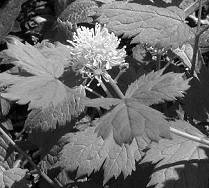 | Baneberry or Herb Christopher, Actaea spicata
This is a relatively rare plant, only growing on limestone in the north of England. It is not uncommon in Ryedale in old, undisturbed woodland, but even there its distribution is strangely patchy; it usually grows under light shade from ash trees, where there is only thin soil over the underlying rock. Despite appearances and the fact that it bears black berries in fruit, it is related to the buttercups. The photo (sorry it is not in colour) shows the feathery white flowers in May. |
 | Marsh Violet, Viola palustris
 A rather unusual violet, with thin, almost papery, kidney-shaped leaves on long, thin stalks. The flowers (detail, right) are very pale mauve, usually with fine radiating lines guiding insects to the nectar. Marsh violets grow in damp, usually somewhat acidic places, such as woodland ditches and boggy areas. They are relatively common but easy to overlook amongst other vegetation. May 2000; May 2003 A rather unusual violet, with thin, almost papery, kidney-shaped leaves on long, thin stalks. The flowers (detail, right) are very pale mauve, usually with fine radiating lines guiding insects to the nectar. Marsh violets grow in damp, usually somewhat acidic places, such as woodland ditches and boggy areas. They are relatively common but easy to overlook amongst other vegetation. May 2000; May 2003 |
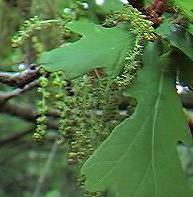 | Oak, Quercus sp.
This photo shows the catkin-like flowers of oak. Like many trees oaks are wind-pollinated, producing clouds of pollen in spring often causing problems for hay-fever sufferers. May 2000. |
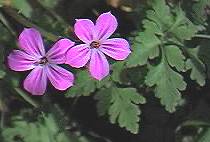 | Herb Robert, Geranium robertianum
Probably the commonest wild geranium, this plant can be found flowering almost throughout the year. It is a fast-growing annual, the leaves of which often turn deep red, especially later in the season. May 2000. |
 | Hawthorn, Crataegus monogyna
Very common in woods and hedges, as well as scrub on overgrown slopes. The hawthorn or may flowers in mid-May in most years, with the entire bush turning white in good blossom years. Close up the family resemblance of the flowers to roses can be seen. In autumn of course these flowers turn into red haws. May 2000. |
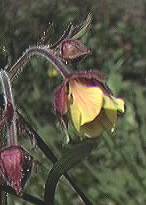 | Avens, hybrid, Geum rivale×urbanum
This is a relatively common hybrid between water avens (below) and the yellow wood avens. This plant has the general structure of the water avens and the colour of the wood avens. Probably it will be sterile and not produce seed. It was growing close to water avens in a wood near Wrelton in which the wood avens also flourish. May 2000. |
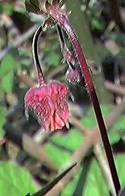 | Avens, water, Geum rivale
A fairly common plant of damp woodland, ditches etc., although the distribution is patchy and there are apparently suitable woods in which it does not seem to thrive. The flowers are of a strange dusky pink which is not common in British flowers. May 2000 (photographed close to the hybrid plant above). |
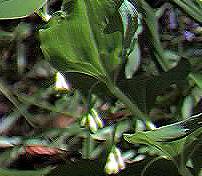 | Solomon’s Seal, Polygonatum multiflorum
An uncommon plant of woodland on limestone, and rare in Ryedale. This plant appeared to be truly wild, but as it was growing near a path it may have been introduced. It is in a wood, in fairly deep shade, and therefore difficult to photograph. May 2000. |
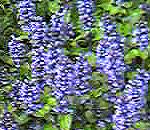 | Bugle, Ajuga reptans
 A common woodland plant, which did particularly well in 2000, producing banks almost as blue as the bluebells. The detail (right) shows the leafy spike of lipped flowers, which are usually blue but can be pink or rarely white. May 2000. A common woodland plant, which did particularly well in 2000, producing banks almost as blue as the bluebells. The detail (right) shows the leafy spike of lipped flowers, which are usually blue but can be pink or rarely white. May 2000. |
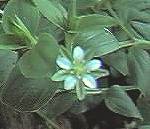 | Three Nerved Sandwort, Moehringia trinerva
A small, rather weedy relative of Chickweed, growing in shady woodland. It is easily recognised by its relatively broad leaves with clear nerves or veins – hence the name. May 2000. |
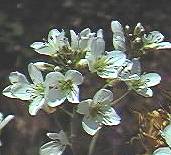 | Bittercress, large, Cardamine amara
Closely related to the Milkmaid, this bittercress grows in wet places, for instance along streamsides and the banks of ponds. This particular specimen was by the spring in Gilling. Large Bittercress is easily distinguished from other similar white or very pale pink crucifers by its prominent purple anthers. May 2000. |
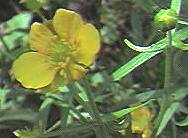 | Buttercup, goldilocks, Ranunculus auricomus
A curious buttercup which usually indicates ancient woodland and prefers limestone. Typically the flowers are incompletely formed, with one or more sepals and petals either very small or missing altogether. The leaves are very confusing in that those at the base of the plant are kidney-shaped and completely different from those higher up, which become progressivly more finely divided, the topmost being little more than green filaments. May 2000 |
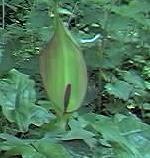 | Lords and Ladies, Arum maculatum
Also known as Cuckoo Pint, the flowers of this wild arum are rather curious, resembling the Arum lily to which they are related. The finger-like spike bears the pollen and attracts flies, which fall down inside the hood-like spathe and are imprisoned until they have pollinated the female parts of the flower-head which lie underneath. Then the spathe withers, and the flower develops into the familiar shiny red berries in autumn. Common in woods, hedge-banks and similar places, the large arrow-shaped shiny green leaves are often one of the first signs of spring. May 2000 |
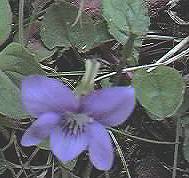 | Violet, common dog, Viola riviniana
The commonest wild violet, this is quite a variable plant. It usually flowers a little later than the Wood Violet, and can be distinguished from that by the spur, which is stout, paler than the rest of the flower, and notched or grooved. However, the two species do hybridise and many intermediate forms can be found. Common in woods, on banks and verges. May 2000. |
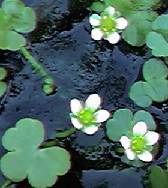 | Water Crowfoot, Ranunculus omiophyllus
A small crowfoot or water buttercup, which in Ryedale only grows in acid pools on the moors. The whole plant is very small, the flowers only about a third of an inch across. There are two closely related species, and this is probably the round-leaved water crowfoot (the other is the ivy-leaved). Upper Rosedale, along the old railway track, 1 May 2000 |
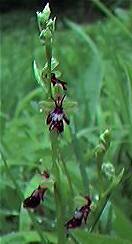 | Orchid, fly, Ophrys insectifera
A small orchid, easy to overlook in its favoured habitat of dappled shade in woodland, or at the edge of woods, on the limestone of southern Ryedale. The flowers closely resemble certain insects (see detail, right, and it is thought this is to attract the flies (which mistakenly try to mate with them!) which act as pollinators. This particularly fine example was one of a group growing in an old quarry in partially cleared woodland near Ampleforth. 23 May 2000. The flowers closely resemble certain insects (see detail, right, and it is thought this is to attract the flies (which mistakenly try to mate with them!) which act as pollinators. This particularly fine example was one of a group growing in an old quarry in partially cleared woodland near Ampleforth. 23 May 2000. |
 | Twayblade, common, Listera ovata
A member of the orchid family, Twayblade has rather unexciting green flowers on strong stems up to a foot tall, rising from the pair of large, prominently veined leaves. Quite common in woods and grassland, especially on the limestone. 23 May 2000. |
 | Vetch, bitter, Lathyrus linifolius (also known as L. montanus)
A small vetch (normally under 6" tall) growing in grassland and the edges of woods, usually on neutral or slightly acid soils. It is the only common vetch without tendrils on the leaves; instead it has a tiny point at the end of the leaves which usually have 3-5 pairs of leaflets. The flowers are either single or in few-flowered heads, of a characteristic pinky-purple fading to an odd greenish-blue. 12/5/03 |
 | Plantain, ribwort, Plantago lanceolata
A really common weed of grassland, lawns, tracks, verges, etc., this plantain has long been used by children to play “soldiers”. The commonest plantain. 12/5/03 |
 | Woodruff, Galium odoratum
A member of the bedstraw family, woodruff grows at the edge of woods, in hedges and on verges especially where the soil is limy; often it can form extensive patches. The plants are up to a foot tall, with small white cross-shaped flowers borne above the whorls of bright green leaves. It is very common in Ryedale. 12/5/03 |
 | Green-winged Orchid, Orchis morio
Quite a rarity in Ryedale, and decreasing throughout Britain where it is generally commoner in the south, this orchid is in many ways similar to the Early Purple Orchid, but smaller and with shorter flower-spikes.
 The two main differences are the leaves, which are never spotted in the green-winged, and the sepals and petals at the top of the flower which form a characteristic hood (in Early Purple the two lateral sepals are spreading or even turned back). This hood is said to be green or prominently green-veined in the books, but most of the specimens we found in the Hole of Horcum had purple hoods, albeit with very obvious veining. There was a considerable variation in colour including one very pale specimen. These orchids were found in 2003 after a special search in their last known Ryedale site, where they had previously been recorded in the 1980s but not seen since; it was very exciting to find them still thriving there, apparently only in one field. There is also a record from 1983 from an old quarry near Appleton-le-Moors but this site has not been re-discovered. (For more pictures see the page Search for the Green-winged Orchids.) 19/5/2003 The two main differences are the leaves, which are never spotted in the green-winged, and the sepals and petals at the top of the flower which form a characteristic hood (in Early Purple the two lateral sepals are spreading or even turned back). This hood is said to be green or prominently green-veined in the books, but most of the specimens we found in the Hole of Horcum had purple hoods, albeit with very obvious veining. There was a considerable variation in colour including one very pale specimen. These orchids were found in 2003 after a special search in their last known Ryedale site, where they had previously been recorded in the 1980s but not seen since; it was very exciting to find them still thriving there, apparently only in one field. There is also a record from 1983 from an old quarry near Appleton-le-Moors but this site has not been re-discovered. (For more pictures see the page Search for the Green-winged Orchids.) 19/5/2003 |
 | Pale Forget-me-not, Myosotis stolonifera (=brevifolia)
A tiny forget-me-not, only an inch or so tall with pale sky-blue flowers, this plant is rare in the whole country, being confined to hills and mountains in northern England and Scotland. It grows in the Hole of Horcum in the small trickles at the headwaters of Levisham Beck – and where it does occur it grows in such abundance it is hard to believe it is a rare plant! It was only just starting to flower when this picture was taken in mid-May but I am told that in a good year in early June the beds of it can be seen from several hundred yards away.
The photo is an extreme detail, the flower being only about 2.5-3mm across. 19/5/2003 |
 | Cowberry, Vaccinium vitis-idaea
Related to bilberry but somewhat less common, cowberry grows locally on the North York Moors. It is evergreen, with neat, rather box-like leaves, and bears small clusters of very pretty pale pink flowers in May.
 These only last a short time, and later develop into sour red berries. 19/5/2003 These only last a short time, and later develop into sour red berries. 19/5/2003 |
 | Adderstongue, Ophioglossum vulgatum
A curious little plant, this is actually a fern; the spike that is just showing bears spores rather than flowers and seeds (this specimen was not fully out). It is not common, and grows in amongst grasses which makes it difficult to spot - especially if there is also sorrel present as the leaves are very similar! It is related to Moonwort. 19/5/2003 |
 | Black Medick, Medicago lupulina
A very common weed, like a tiny yellow clover, growing in roadside verges, along tacks, in rough grassland, even lawns. It is very similar to Lesser Trefoil, but the seedpods are different, becoming black in Medick. Sometimes there are dark spots on the leaves, and there is always a tiny point at the apex of the central leaflet, which is a reliable distinguishing feature (the trefoil has a notch here). 21/5/2003 |
 | Wavy Bittercress, Cardamine flexuosa
A very common, rather uninspiring weed, like a slightly larger Hairy Bittercress, growing in woods and waste places such as wall bottoms, and also as a garden weed. It can be distinguished from Jumping Cress (Hairy Bittercress) by the zig-zag stems, and also it tends to be taller. If you have a hand lens Wavy Bittercress has 6 stamens, Jumping Cress only 4, but this is not something most of us can see with the naked eye! 21/5/2003 |
 | Wintercress, Barbarea vulgaris
Another common weed, related to the bittercress above, with the characterisitic 4-petalled flowers of the cabbage family Cruciferae. This plant has shiny green leaves which are more or less lobed and yellow flowers like those of mustard. Like many crucifers it is untidy as it runs to seed. Very common along roadsides and on waste ground (this specimen was growing at the foot of the village railings in Hovingham). 21/5/2003 |
 | Germander Speedwell, Veronica chamaedrys
Also known as Birdseye Speedwell this is probably the prettiest (and certainly the showiest) of the common wild speedwells. It is common along grassy verges and in hedge bottoms, and can also be a troublesome garden weed as it creeps with long, wiry stems. It can produce quite extensive patches of glorious blue flowers, although these do not last very long. The flower spikes arise from the axes of the leaves like those of Wood Speedwell, but this is an altogether more robust plant, with darker green leaves and much bluer flowers. 21/5/2003 |
 | Broom, Cytisus scoparius
A fairly common shrub along woodland edges and verges, especially where the soil is limy - Swainsea Lane north of Pickering and the road past the Roman camps at Cawthorn are prime sites. Wild broom is always yellow but with the pea-flowers familiar from the garden varieties. The trefoil leaves are very small and often drop early, leaving the bush with its angled green stems, yellow flowers and blackish seed-pods that explode in the sunshine shooting the small, hard pea-like seeds a surprisingly long way. 21/5/2003
|
 | Red Clover, Trifolium pratense
Very common as a weed and a roadside plant, also in grass fields and meadows. Red clover is taller than white, with larger flower-heads. It often has pale markings on the leaves as here. The flowers are rich in sweet nectar and so much visited by insects including butterflies. 4/6/2003
|


 The green “shamrock” leaves have a sharp acid tang, reflected in the Latin specific acetosella. 8/5/99
The green “shamrock” leaves have a sharp acid tang, reflected in the Latin specific acetosella. 8/5/99
 It forms a shrub or small tree and is a true Prunus cherry, actually quite closely related to the wild cherry. The individual flower-spikes (see right) are very attractive; the flowers have a strong almondy scent during their brief flowering season, usually only a week or so in early May. The fruit is in the form of small black “cherries” far too bitter for human consumption! 29/4/2000
It forms a shrub or small tree and is a true Prunus cherry, actually quite closely related to the wild cherry. The individual flower-spikes (see right) are very attractive; the flowers have a strong almondy scent during their brief flowering season, usually only a week or so in early May. The fruit is in the form of small black “cherries” far too bitter for human consumption! 29/4/2000

 unfortunately as this habitat is “improved” out of existence this beautiful flower is decreasing throughout the country. This little group was growing at the edge of the golf course at Gilling. The detail (right) shows a plant growing at the edge of the top fishpond in Gilling Woods on 29 April 2000. Milkmaids are usually mauve, but sometimes they are almost white, when they can be confused with the related Large Bittercress, which has purple anthers whereas those of the Milkmaid are yellow. 9/5/99
unfortunately as this habitat is “improved” out of existence this beautiful flower is decreasing throughout the country. This little group was growing at the edge of the golf course at Gilling. The detail (right) shows a plant growing at the edge of the top fishpond in Gilling Woods on 29 April 2000. Milkmaids are usually mauve, but sometimes they are almost white, when they can be confused with the related Large Bittercress, which has purple anthers whereas those of the Milkmaid are yellow. 9/5/99






 A rather pale, yellowish-green, weedy speedwell, with pale mauve-blue flowers, it grows in many Ryedale woods, often in quite large patches. It cn be mistaken for the much bluer, more upright birdseye speedwell, but that does not often grow in woods. 12/5/03
A rather pale, yellowish-green, weedy speedwell, with pale mauve-blue flowers, it grows in many Ryedale woods, often in quite large patches. It cn be mistaken for the much bluer, more upright birdseye speedwell, but that does not often grow in woods. 12/5/03








 A curious plant, not closely related to any other British wild flower (allied to Trillium). Herb Paris is uncommon, growing in damp spots in old, undisturbed woodland on limestone. It is hard to spot growing among Dog’s Mercury, reaching almost a foot in height; usually a colony of a dozen or so plants are found growing together. The whole plant is divided into fours, from the leaves (see left) to the various elements of the flower – 4 sepals, 4 petals, 8 stamens, 4 styles (see detail, right). The fruit is a black berry. 19/5/99
A curious plant, not closely related to any other British wild flower (allied to Trillium). Herb Paris is uncommon, growing in damp spots in old, undisturbed woodland on limestone. It is hard to spot growing among Dog’s Mercury, reaching almost a foot in height; usually a colony of a dozen or so plants are found growing together. The whole plant is divided into fours, from the leaves (see left) to the various elements of the flower – 4 sepals, 4 petals, 8 stamens, 4 styles (see detail, right). The fruit is a black berry. 19/5/99
 Probably the commonest buttercup, with shiny bright yellow flowers; grows along roadsides, in hedge bottoms and as a garden weed, with runners that root rather like strawberries. The sepals lie up close against the petals (detail right), in contrast to those of Bulbous Buttercup (below), and the flower-stalk is noticeably ridged. This buttercup usually comes into flower at about the same time as the taller Meadow buttercup (below) and then continues right through the summer.The leaves often have pale blotches on them 30/5/99; 21/5/3 (detail)
Probably the commonest buttercup, with shiny bright yellow flowers; grows along roadsides, in hedge bottoms and as a garden weed, with runners that root rather like strawberries. The sepals lie up close against the petals (detail right), in contrast to those of Bulbous Buttercup (below), and the flower-stalk is noticeably ridged. This buttercup usually comes into flower at about the same time as the taller Meadow buttercup (below) and then continues right through the summer.The leaves often have pale blotches on them 30/5/99; 21/5/3 (detail)



 This stately tree is an introduction but grows well especially in parkland. The large, ornamental flower “candles” are a splendid sight in late spring. Later, of course, they produce conkers in their outer spiny protective “hedgehog” fruits. The flowers are beautiful seen close up (left) as well as in groups (right). 30/5/99
This stately tree is an introduction but grows well especially in parkland. The large, ornamental flower “candles” are a splendid sight in late spring. Later, of course, they produce conkers in their outer spiny protective “hedgehog” fruits. The flowers are beautiful seen close up (left) as well as in groups (right). 30/5/99
 Not really a foxglove (though in the same botanical family Scrophulariaceae), this pretty little plant grows up to 6" tall. It is an introduction, probably a garden escape, but finds conditions on the walls of Helmsley Castle greatly to its liking (see right). The flowers are very attractive close up (left). 29/5/99
Not really a foxglove (though in the same botanical family Scrophulariaceae), this pretty little plant grows up to 6" tall. It is an introduction, probably a garden escape, but finds conditions on the walls of Helmsley Castle greatly to its liking (see right). The flowers are very attractive close up (left). 29/5/99
 Wild Garlic covers vast areas in Ryedale’s woods, often carpeting the ground completely (below). The leaves are broad, almost like those of lily-of-the-valley, but instantly recognisable by the pungent smell of garlic they produce when bruised. The flowers are pure white, and actually delicate and beautiful in close-up (right); they have surprisingly little of the smell! After flowering the whole plant dies down rapidly, often leaving bare earth. May 2000
Wild Garlic covers vast areas in Ryedale’s woods, often carpeting the ground completely (below). The leaves are broad, almost like those of lily-of-the-valley, but instantly recognisable by the pungent smell of garlic they produce when bruised. The flowers are pure white, and actually delicate and beautiful in close-up (right); they have surprisingly little of the smell! After flowering the whole plant dies down rapidly, often leaving bare earth. May 2000


 A rather unusual violet, with thin, almost papery, kidney-shaped leaves on long, thin stalks. The flowers (detail, right) are very pale mauve, usually with fine radiating lines guiding insects to the nectar. Marsh violets grow in damp, usually somewhat acidic places, such as woodland ditches and boggy areas. They are relatively common but easy to overlook amongst other vegetation. May 2000; May 2003
A rather unusual violet, with thin, almost papery, kidney-shaped leaves on long, thin stalks. The flowers (detail, right) are very pale mauve, usually with fine radiating lines guiding insects to the nectar. Marsh violets grow in damp, usually somewhat acidic places, such as woodland ditches and boggy areas. They are relatively common but easy to overlook amongst other vegetation. May 2000; May 2003






 A common woodland plant, which did particularly well in 2000, producing banks almost as blue as the bluebells. The detail (right) shows the leafy spike of lipped flowers, which are usually blue but can be pink or rarely white. May 2000.
A common woodland plant, which did particularly well in 2000, producing banks almost as blue as the bluebells. The detail (right) shows the leafy spike of lipped flowers, which are usually blue but can be pink or rarely white. May 2000.






 The flowers closely resemble certain insects (see detail, right, and it is thought this is to attract the flies (which mistakenly try to mate with them!) which act as pollinators. This particularly fine example was one of a group growing in an old quarry in partially cleared woodland near Ampleforth. 23 May 2000.
The flowers closely resemble certain insects (see detail, right, and it is thought this is to attract the flies (which mistakenly try to mate with them!) which act as pollinators. This particularly fine example was one of a group growing in an old quarry in partially cleared woodland near Ampleforth. 23 May 2000.




 The two main differences are the leaves, which are never spotted in the green-winged, and the sepals and petals at the top of the flower which form a characteristic hood (in Early Purple the two lateral sepals are spreading or even turned back). This hood is said to be green or prominently green-veined in the books, but most of the specimens we found in the Hole of Horcum had purple hoods, albeit with very obvious veining. There was a considerable variation in colour including one very pale specimen. These orchids were found in 2003 after a special search in their last known Ryedale site, where they had previously been recorded in the 1980s but not seen since; it was very exciting to find them still thriving there, apparently only in one field. There is also a record from 1983 from an old quarry near Appleton-le-Moors but this site has not been re-discovered. (For more pictures see the page
The two main differences are the leaves, which are never spotted in the green-winged, and the sepals and petals at the top of the flower which form a characteristic hood (in Early Purple the two lateral sepals are spreading or even turned back). This hood is said to be green or prominently green-veined in the books, but most of the specimens we found in the Hole of Horcum had purple hoods, albeit with very obvious veining. There was a considerable variation in colour including one very pale specimen. These orchids were found in 2003 after a special search in their last known Ryedale site, where they had previously been recorded in the 1980s but not seen since; it was very exciting to find them still thriving there, apparently only in one field. There is also a record from 1983 from an old quarry near Appleton-le-Moors but this site has not been re-discovered. (For more pictures see the page 

 These only last a short time, and later develop into sour red berries. 19/5/2003
These only last a short time, and later develop into sour red berries. 19/5/2003





